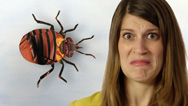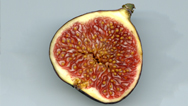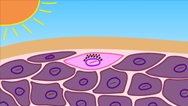The Rocketing Bacterium
- Posted 09.15.16
- NOVA
The food poisoning, Listeria, has a very special way of hijacking your cells and can survive the freezer. Learn more in this episode of Gross Science.
Transcript
The Rocketing Bacterium
Posted: September 15, 2016
Your average food poisoning can be pretty unpleasant, with vomit at one end and diarrhea at the other. But sometimes it can be deadly. Meet Listeria—a microbe with a very special way of hijacking your cells—and it might even kill you in the process.
I’m Anna Rothschild and this is Gross Science.
A single Listeria bacterium is only about a hundredth the width of a human hair. But don’t let its small size fool you. A Listeria infection, called listeriosis, is a serious disease that can kill up to 20% of people affected. It is especially deadly to children, pregnant women and the elderly.
It starts by growing on our food—anything from dairy, to meat, to fruits and vegetables—and it’s even tough enough to survive the freezer. If the food isn’t adequately washed or cooked, Listeria gets a free ride down your digestive tract.
When it gets absorbed by the small intestine, Listeria has to face our white blood cells. These cells usually protect us by engulfing disease-causing agents, trapping them in tiny cellular jails—these compartments called phagosomes. And that’s exactly what starts to happen. It may seem like Listeria’s met its match until two weeks later when, the white blood cell starts rippling and bulging ominously.
It turns out, getting engulfed was all part of Listeria’s plan. Once inside, it makes holes in the phagosome within minutes and escapes into the gooey interior of the cell. Then, it hijacks the host cell’s skeleton to move around inside.
Unlike our bone skeletons, cell skeletons are almost like legos—tiny proteins that assemble where they’re needed and disassemble where they’re not. But Listeria steals a special molecule from its host that causes the skeleton to assemble behind it. As the skeleton grows, it pushes the bacterium along like a cellular rocket. En route, Listeria gathers nutrients, grows, and reproduces.
Each time these rockets hit the outer membrane of the cell, it ripples and stretches until the army of Listeria bursts through. At that point, the bacteria can puncture their way into neighboring cells, or they can ride your bloodstream to reach the liver, spleen and even the brain. And in these late stages, the infection can become deadly.
Now, Listeria is actually quite rare—but when there is an outbreak, these bacteria can travel through our mass food production system into the bodies of many people. So for the last several years, the Centers for Disease Control and Prevention have taken a new step to stop outbreaks.
Whenever there’s an infection, scientists sequence the Listeria’s DNA and compare it to other cases of infection. That way, they can use the eating patterns of patients with genetically similar infections to track down contaminated food sources. This new technique may have contributed to the declining numbers of people infected during each outbreak.
Still, the recent outbreak in May 2016 is a reminder to stay cautious. Rinse and scrub produce and cook animal products thoroughly before eating them. If you’re wondering if your food might be contaminated, visit foodsaftety.gov for information about food recalls.
These simple steps can help prevent this crafty little bacteria from finding its way inside you.
Ew.
Credits
PRODUCTION CREDITS
- Host
- Anna Rothschild
- Writer, Illustrator, Animator
- Eben E. B. Bein
- Spying
- Music Provided by APM
- Original Footage
- ©WGBH Educational Foundation 2016
IMAGES AND FOOTAGE
- Movie S3 from Rickettsia Actin-Based Motility Occurs in Distinct Phases Mediated by Different Actin Nucleators
- Courtesy Dr. Thomas Burke
http://www.ncbi.nlm.nih.gov/pubmed/24361066 - Listeria monocytogenes moving in PtK2 cells
- Many thanks to Dr. Julie Theriot and her lab members
http://cmgm.stanford.edu/theriot/ - Chicken meat Processed At Food Processing Factory. Poultry Production line
- Pond5/mrs_veronik
- Electron microcraph of a Listeria bacterium in tissue
- CDC/Dr. Balasubr Swaminathan; Peggy Harris
- Menschenhaar 200 fach
- Wikimedia Commons/Jan Homann
- Female shadow with organs
- Wikimedia Commons/Mikael Häggström
SFX
- Cockroaches
- Freesound/StateAardvark
(used with permission from author) - Squeak Pack/squeak_10
- Freesound/Corsica_S
- Male drinking slurping aaaaaaaaaaah small belch
- Freesound/anton
- Running water bubbles 02
- Feesound/kijjaz
- Wink
- Freesound/bennychico11
- Slide whistle up 01
- Freesound/joedeshon
- Slide whistle down 01
- Freesound/joedeshon
- MouthPop
- Freesound/HerbertBoland
- Bubbles Popping
- Freesound/ch0cchi
- Produced by WGBH for PBS Digital Studios
POSTER IMAGE
- Listeria
- ©WGBH Educational Foundation 2016
Sources
Want more info?
The CDC on Listeria:
https://www.cdc.gov/listeria/
Why Food Labels Don’t Mean What You Think:
http://www.pbs.org/wgbh/nova/next/body/food-expiration-dates/
Related Links
-

Gross Science
Bizarre stories from the slimy, smelly, creepy world of science.
-

What Causes Runner's Diarrhea?
Ever get an uncontrollable urge to poop in the middle of a long run? You're not alone.
-

What’s Lurking Inside Figs?
Figs are delicious—but they may contain the bodies of dead wasps.
-

What Really Causes Sunburns?
The way the sun damage your skin is weirder than you ever thought.

